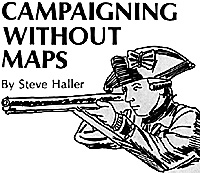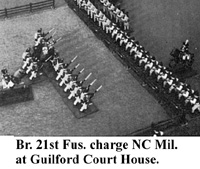 Wargamers who enjoy the variety that a campaign
offers for the use of their collections are often discouraged
by the time and clutter involved when maps are used. An
alternative method might employ the use of a scenario
based on a historical campaign (complete with OB's, etc)
which allows the elements of choice and chance to
determine the nature of each battle of the campaign. Each
battle is assigned a number of points that are awarded
based on the results of the battle (e.g., comparison of
casualty ratios).
Wargamers who enjoy the variety that a campaign
offers for the use of their collections are often discouraged
by the time and clutter involved when maps are used. An
alternative method might employ the use of a scenario
based on a historical campaign (complete with OB's, etc)
which allows the elements of choice and chance to
determine the nature of each battle of the campaign. Each
battle is assigned a number of points that are awarded
based on the results of the battle (e.g., comparison of
casualty ratios).
A small group of gamers in the Dayton, Ohio, area recently refought the Cowpens-Guilford Courthouse Campaign of 1781 using such a method. Our specific experience illustrates the method in detail. The campaign used no maps and was subject to the following general conditions (in addition to the scenario of potential battles):
1. Tabletop rules used were The Whites of Their Eyes ( The Courier, V11-7).
2. Terrain not available from historical accounts was determined randomly using the method outlined in " Random Terrain Placement" (Wargamer's Digest, August, 1977).
3. A 1:10 figure to man ratio was used with the historical OB.
4. Twenty-five percent of tabletop casualties return to all units after the battle (except units reduced to below 25%, which were eliminated from OB for one month). Another 25% of Americans (including Loyalists) return in one month, while the same is true for British and Hessian after two months.
5. Staff officer casualties return immediately if they roll 4, 5, 6 on one die. 6. A tabletop commander can retain up to one-third of his total forces in reserve off the table, but prior to the battle beginning must record where and when these units will enter. He must give the enemy one turn's advance notice of this information. These units may enter at any point in the rear of his own army, but no more than half way up the table on either flank.
7. General familiarity with the campaign and OB is assumed in advance.
 THE CAMPAIGN I
THE CAMPAIGN I
JANUARY, 1781
A. SCENARIO: General Morgan invades South Carolina with 700 light troops and regulars and successfully links up with Pickens' 550 militia and riflemen (by rolling 1-4 on a single die). Sumter's 500 man force failed to join (by not rolling the required 1-3 on a single die). Morgan now faced three alternative combats:
-
1) Fight Tarleton's 1200 man elite and light force at
Cowpens as the historical battle worth 5 points. If Morgan
wins, Sumter will automatically join him if he attacks
Ninety-Six or Augusta for a second 5 point battle.
2) Attack Cruger's 75~man garrison at Fort NinetySix for a 5 point battle. Tarleton can reinforce Cruger by rolling 1-4 on a turn set by rolling one die. Sumter will join Morgan if the Americans win, but they have to fight Tarleton for another 5 point battle trandom terrain) on a roll of 1-4.
3) Attack Browne's 65-man garrison at Augusta for 5 points. Cruger can assist with 400 men by rolling 1-3. and Clark can send 65 men from Savannah by rolling 1-4. If Morgan wins, Sumter will join him to fight Tarleton if a 1-4 is rolled (random terrain).
B. RESULTS: Morgan and Pickens attacked Augusta, which was reinforced late in the battle by Clark. Each side lost 40%, which gave the Americans a "marginal victory" (3 points to British 2 points). Tarleton failed to intercept the Americans, and Morgan returned to Greene's main army without Pickens.
II. FEBRUARY, 1781
A. SCENARIO: Cornwallis and Tarleton chase Greene and Morgan into North Carolina. This 3800 man force of good troops hounds Greene's mixed force of about 2000. Davidson joins Greene with 1000 North Carolina militia (by rolling 1-3). The following engagements were possible and determined by rolling one die:
-
1) Cowen's Ford will be defended by Davidson as the
historical battle on a roll of 1-4. Greene can detach only
light troops to assist on a move set by rolling one die.
Battle is worth 5 points.
2) A collision battle on random terrain will occur involving all units if a 5 or 6 is rolled. This battle is worth 10 points.
B. RESULTS: Cornwallis engages Greene and Davidson in an open battle by rolling 5 or 6 and achieved a "sound British victory" (losing 29% to Greene's 51%). This resulted in 6 points for the British and 4 for the Americans. American losses were concentrated among the expendable N. C. Militia, while the British 71st Highland and Tarleton's Legion took most of the King's losses.
 III. MARCH,
1781
III. MARCH,
1781
A. SCENARIO: Greene's somewhat battered army was now reinforced by 2500 Virginia and North Carolina militia. Davidson's remnants had gone home. Greene now marched with 3800 men to fight Cornwallis' 3000 men for the final 15 point battle at either:
-
1) Guilford Courthouse as the historical battle (by
rolling 1-4).
2) Collision battle on random terrain (rolling 5 or 6).
B. RESULTS: Greene achieved a "marginal victory" at Guilford Courthouse after each side had lost 60%. The British lack of light troops (Tarleton) was decisive. The Americans received 9 points to the British 6 points.
IV. CONCLUSION
Greene won the campaign with a total for the three battles of 16 points to Cornwallis' 14 points. Although the end result resembled the historical campaign, the two engagements preceeding Guilford offered some exciting, yet possible historically, variations. Most importantly, the sacrifice of some "strategic" flexibility permitted us to spend our wargaming time at the tabletop using our miniatures. Yet each battle was part of a larger picture, and the campaign could be redone with even different results.
Back to Table of Contents -- Courier Vol. 1 #1
To Courier List of Issues
To MagWeb Master Magazine List
© Copyright 1979 by The Courier Publishing Company.
This article appears in MagWeb (Magazine Web) on the Internet World Wide Web.
Other military history articles and gaming articles are available at http://www.magweb.com